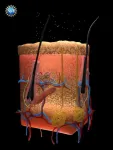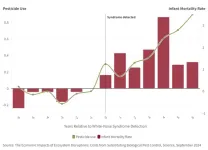(Press-News.org) A new study reveals that young patients treated with psychiatric medications receive potentially dangerous combinations with concerning frequency.
Researchers from Rutgers Health and other institutions analyzed New York State Medicaid records for more than 141,000 patients receiving any psychiatric medication. Nearly 400 of them received at least one potentially dangerous combination t for one month or longer. Doctors refer to these as severe drug-drug interactions, and their use is typically considered "contraindicated" or recommended against.
Senior study author Lawrence Kleinman, professor of pediatrics at Rutgers Robert Wood Johnson Medical School, cautioned that while some children whose illness is resistant to usual treatments may receive more benefit than the risk from the combination, "Good practice demands that patients and caregivers be informed of and assent to risks and benefits, including informing them that the intended pair of medications is typically contraindicated."
The study, published in BMC Primary Care, analyzed 2014 prescription data for New York Medicaid enrollees under 21. While the overall rate of these potentially dangerous combinations is small —about 3 in 1,000 children who filled any mental health medication prescription had at least one month of prescription overlap, and 5 per 1,000 had any overlap — these cases represent significant potential for harm or death. Kleinman noted that New York State Medicaid had previously implemented a program to reduce harmful drug interactions, suggesting numbers might be higher in other populations.
Polypharmacy (use of multiple medications) is very common, with nearly 38 percent of patients in the study filling two or more medications with at least one month overlap, generating more than 11,000 distinct drug combinations.
The study offered some reassurance: the most commonly filled mental health medications were stimulants typically used for conditions such as attention-deficit/hyperactivity disorder, and these were never combined with other drugs to create severe interaction risks. Most contraindicated combinations involved the antipsychotic drug ziprasidone, which can increase the risk of potentially fatal heart rhythm abnormalities such as QT interval prolongation or serotonin syndrome when paired with certain medications. Kleinman noted, "Because of this risk, the FDA has warned that ziprasidone should not be prescribed with other drugs that have demonstrated QT prolongations."
About 32 percent (364) of the 1,121 patients prescribed ziprasidone also received a contraindicated partner medication for at least 30 days. It rose to 54 percent when considering prescription overlap of any duration.
Other common risky combinations involved antidepressants such as fluoxetine (Prozac) and trazodone paired with various antipsychotic medications, risking life-threatening QT interval prolongation and serotonin syndrome.
Researchers analyzed prescription claims data for all New York State Medicaid enrollees younger than 21 in 2014, identifying 84 distinct behavioral and mental health medications. They flagged combinations with severe interactions according to established drug interaction databases.
The team examined different durations for overlapping prescriptions: one day, 15 days, or 30 days. Even at the 30-day threshold, 392 young patients received contraindicated combinations, rising to 651 for any overlap.
Contraindicated combinations were more common in adolescents and young adults than younger children, with no children under 6 receiving risky combinations. While boys were more likely to receive any mental health medication, there was no gender difference in potentially dangerous pair usage.
Of over 20,000 clinicians prescribing psychiatric medications, 386 prescribed at least one contraindicated pair. Most were psychiatrists rather than pediatricians, which Kleinman suggested may be because psychiatrists likely see patients with more severe mental illness.
Kleinman added that insufficient research into treating mental illness in children often left clinicians and families "flying blind."
Among the study’s limitations was the age of its data. Prescribing patterns may have changed, especially post-COVID-19. Also, researchers couldn't determine if patients took all medications as prescribed or if prescribers and parents made intentional, informed decisions about risky combinations.
Nevertheless, Kleinman emphasized the need for ongoing monitoring of prescription patterns to prevent potential harm. He suggested health systems and insurers implement systems to flag these rare but concerning cases for review.
"We believe that our data and this methodology could serve as the beginning of such efforts," Kleinman said. "Ultimately, such ongoing monitoring could reduce harmful prescription combinations and medication-related adverse events."
END
Risky combos of psychiatric drugs prescribed for young patients
2024-09-05
ELSE PRESS RELEASES FROM THIS DATE:
A window into the body: groundbreaking technique makes skin invisible
2024-09-05
Images, animations, and video available in our NSF portal:
https://nsf.widencollective.com/portals/ematkiby/TheInvisibleMouseEmbargoed
Access Code: Le9ANH7tYTdr
Researchers have developed a new way to see organs within a body by rendering overlying tissues transparent to visible light.
The counterintuitive process—a topical application of food-safe dye—was reversible in tests with animal subjects, and may ultimately apply to a wide range of medical diagnostics, from locating injuries to monitoring digestive disorders to identifying cancers.
Stanford University researchers published the research ″Achieving optical ...
Serotonin to bounce back from adversity
2024-09-05
The simple act of observing others cope with a traumatic experience can increase our capacity for resilience and prevent the pathological states that can result from it, notably depression. Neuroscientists at UNIL have demonstrated the presence of this “emotional contagion” in mice, and successfully deciphered its mechanism. The neurotransmitter serotonin, released in a brain structure called the habenula, has been shown to be the key to resilience. This discovery, published in Science, revisits the role of serotonin ...
Yellow dye solution makes tissue transparent on living animals
2024-09-05
In a pioneering new study, researchers made the skin on the skulls and abdomens of live mice transparent by applying to the areas a mixture of water and a common yellow food coloring called tartrazine.
Dr. Zihao Ou, assistant professor of physics at The University of Texas at Dallas, is lead author of the study, published in the Sept. 6 print issue of the journal Science.
Living skin is a scattering medium. Like fog, it scatters light, which is why it cannot be seen through.
“We combined the yellow dye, which is a molecule that absorbs most light, ...
The collapse of bat populations led to more than a thousand infant deaths
2024-09-05
Bats are considered a natural pesticide, widely relied on by farmers as an alternative to chemical pesticides to protect their crops from insects. But since 2006, many bat populations have collapsed in counties in North America due to an invasive fungus found in the caves bats use during the day and throughout winter that causes what is known as White-Nose Syndrome. A new study in Science uses their sudden collapse to explore whether farmers turned to chemical pesticides, and whether doing so impacts human health. It finds that farmers did increase their pesticide use, leading to more than 1,000 infant deaths.
“Bats ...
Emotional contagion promotes resilience via serotonin release in mice
2024-09-05
“Bystander” mice that briefly watched other mice be harmed show fewer signs of behavioral despair when faced with their own harmful event, compared to mice who do not observe their fellow mice being harmed. The negative emotional contagion experienced by the bystander mice appears to build resilience against a depressive-like state, according to new research by Sarah Mondoloni and colleagues. Mondoloni et al. demonstrate that resilience in these mice requires an increase in serotonin release in a part of the brain called the lateral habenula. “These findings support the notion that, as is the case in humans, graded trauma can be resilience-promoting, enabling ...
Tiny glass beads indicate volcanism on the Moon 120 million years ago
2024-09-05
There were volcanic eruptions on the Moon as recently as 120 million years ago, according to a new analysis of a lunar sample collected by the Chang’e‑5 mission. Samples collected by the Apollo, Luna and Chang’e‑5 missions have previously shown there was widespread basaltic volcanism on the Moon extending from about 4.4 to 2.0 billion years ago. The new findings demonstrate that volcanism persisted much longer than was previously suspected, at least on smaller, more localized scale. Bi-Wen Wang, Qian W.L. Zhang and colleagues sorted through more than 3000 tiny glass beads they recovered from a lunar sample collected by Chang’e‑5, examining the bead’s ...
Injected fibroblasts transform to give thin skin a tough new identity
2024-09-05
The thick and tough skin on our palms and soles, called volar skin, stands up well under high-pressure conditions. This type of skin would be welcome on the limb stumps of amputees, since these points of contact with prostheses are covered in thin, non-volar skin that can be damaged over time. Now, Sam Lee and colleagues demonstrate that an injection of volar fibroblasts into non-volar skin in a group of human volunteers can promote volar features in the thin skin that last up to five months. Based on their analysis, Lee et al. are now enrolling amputees in a phase 2 clinical trial to further explore volar fibroblasts as a future ...
Novel study reveals how aging immune system fuels cancer growth, potentially opening new avenues for prevention
2024-09-05
New York, NY [September 5, 2024]—A novel study by researchers at the Icahn School of Medicine at Mount Sinai addresses a critical yet under-explored question in cancer research: Why is aging the biggest risk factor for cancer? The study reveals how an aging immune system spurs tumor growth, offering new insights into cancer prevention and treatment, especially for older adults.
Details on the findings were reported in the September 5 Online First Release of Science [DOI:10.1126/science.adn0327]. In preclinical models, the research team found that anakinra, a drug typically used for inflammatory conditions such as rheumatoid arthritis, can be repurposed to block harmful signals between ...
Researchers prove 120-million-year-old volcanism on moon
2024-09-05
Extensive geologic evidence of ancient volcanic activity can be found on the Moon, but how long this volcanism persisted has been unclear. However, Prof. LI Qiuli’s Lab at the Institute of Geology and Geophysics of the Chinese Academy of Sciences (IGGCAS) has recently identified three volcanic glass beads from lunar soil samples collected by the Chang’e-5 mission. Their research shows that the beads were formed 123±15 million years ago (Ma), thus representing the youngest lunar ...
State-by-state data boosts bird conservation planning
2024-09-05
ITHACA, N.Y. – New data summaries from the Cornell Lab of Ornithology’s eBird platform will help state wildlife planners assess the status of bird populations that live in or pass through their state – a crucial tool in protecting species.
A team of data scientists at eBird, the participatory science platform, has packaged summaries covering every bird species, in every state, and made them available online for free. These data summaries will help states prepare their federally required ...





